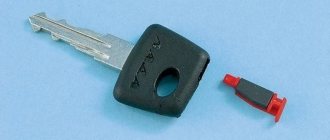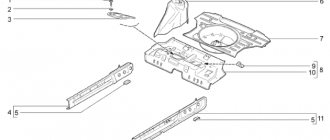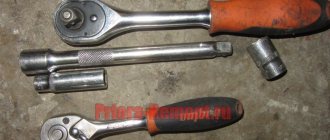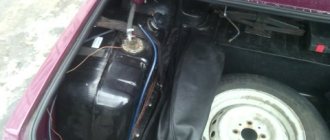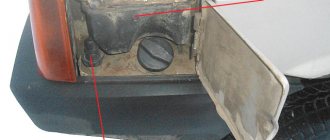Grant fuel cap valve
- To the beginning of the forum
- Forum Rules
- Old design
- FAQ
- Search
- Users
Eat!
Nowadays, 1.6L cars are equipped with covers with valves (code 21103-хххххххххх), the valve in them is designed specifically for vacuum. Or maybe there was still a little pressure to open it? How to find out?
Tom669
What is there under the rear left wheel, where exactly? I'll have to take a look, maybe it's there.
UDima
So you suck too?
For the first time I was simply amazed how much air he needed.
direct
You see, if the tank is completely sealed, then if you leave it from full filling, you will get 40 liters of vacuum with unknown compression force. As I say, I don’t remember on which car there were cases of the gas tank collapsing. And it’s probably hard for the fuel pump to pump.
Eat! Nowadays, 1.6L cars are equipped with covers with valves (code 21103-хххххххххх), the valve in them is designed specifically for vacuum.
Or maybe there was still a little pressure to open it? How to find out?
There is no such valve in nature. Your engine is at least tuned for Ero-2. So some vacuum in the tank (and under certain circumstances there may be slightly increased pressure) is normal. And the tanks were crushed due to crookedly installed gravity valves, or when the drainage of machines under Russia-87 standards was pinched.
Oops. While I was writing, how much has already been added. It turns out there is a valve. I take back my words about his absence. Apparently they don’t put a safety valve on the way to the adsorber, but instead in the lid. I don’t refuse the rest of the words.
UDima
So you suck too?
For the first time I was simply amazed how much air he needed.
I have excessive pressure, sometimes you start to unscrew the plug, and a whistle blows from there, and sometimes not much. I haven't noticed any vacuum in the tank yet.
Didn’t the crazy people touch your adsorber (turn it off, remove it, etc.)?
Source
What not to do
First, let's go back a little to the previous section. You need to be very careful when heating the hatch with a hairdryer, as high heat can damage the paintwork.
When working with exhaust fumes, try to keep the hose away from your nose and eyes to avoid inhaling the exhaust.
Car fuel filler flaps on most cars are quite delicate, and they are easier to damage than it seems. This is also true for the following cars:
What to do if a self-tapping screw gets into the wheel: pull it out or not
- Volkswagen Polo Sedan;
- Skoda Rapid;
- Nissan Teana;
- Renault Duster;
- Volkswagen Tiguan;
- Toyota Avensis;
- Volkswagen Passat;
- Lada Priora;
- Ford Focus;
- BMW X5;
- Skoda Octavia A5, etc.
Often on the same forums and thematic sites there are recommendations that contradict common sense.
No, if you deliberately want to damage your own car, feel free to use these methods. If you want to cope with freezing safely and without consequences, categorically refuse these methods.
I can highlight 2 most common mistakes. But first about WD40. A universal remedy used everywhere. In our case, it is a useless liquid. The effectiveness against freezing is zero.
And here's what you absolutely shouldn't do:
- Break out the hatch using physical force. The first thing the driver thinks of is to do just that. Some people pull with their hand, others insert a thin screwdriver into the gap and use leverage. Why shouldn't you do this? For starters, it's easy to damage the paintwork. But plus there is still a chance of breaking the hatch hinges, which are often made of plastic;
- Using boiling water. When freezing, this should absolutely not be done. Pouring boiling water over an icy hatch will probably cause problems with the paintwork. Especially when it’s below -15 degrees outside. Plus the water can penetrate even deeper. It is unlikely that you will then want to fight rust or remove water from the gas tank while simultaneously changing the hatch.
That's sorted out. If you have the idea of pulling out the door or pouring boiling water on it, remember the possible consequences.
Think before you act. Often the opposite happens.
Gas tank cap with lock 1118 Kalina, 2170 Priora, 2190 Granta, 2123 Chevrolet Niva
| Day | Working hours | Break |
| Monday | 09:00 — 18:00 | |
| Tuesday | 09:00 — 18:00 | |
| Wednesday | 09:00 — 18:00 | |
| Thursday | 09:00 — 18:00 | |
| Friday | 09:00 — 18:00 | |
| Saturday | 09:00 — 17:00 | |
| Sunday | 09:00 — 16:00 |
* Time specified for the region: Russia, Tolyatti
Return and exchange conditions
The company returns and exchanges this product in accordance with legal requirements.
Return deadlines
Returns are possible within 7 days after receipt (for goods of good quality).
Return delivery of goods is carried out by agreement.
According to current legislation, you can return a product of proper quality or exchange it if: - the product has not been used and has no traces of consumer use: scratches, chips, abrasions, stains, etc.; - the product is fully equipped and the original packaging is preserved; -all labels and factory markings are preserved; - the product retains its presentation and its consumer properties. Exceptions The consumer may be refused an exchange or return of non-food products of good quality included in the List of Goods Not Subject to Exchange or Return. Dear customers, if you are dissatisfied with the product received, please notify us by phone. +79033338253 and maintain the presentation of the goods and packaging.
Source
Freezing Prevention
To avoid an unpleasant situation at a gas station, you should take care in advance of the serviceability of the hatch and its proper condition. Even before the onset of cold weather, it is advisable to inspect the hinges, locking mechanism and filler cap. The hatch is dismantled and the metal parts are cleaned of corrosion. When reassembling, all components are generously coated with grease.
If you don’t have enough time for disassembly, you can apply silicone or graphite lubricant to the parts. These substances repel water, preventing its accumulation at points of contact and subsequent freezing. There is no point in lubricating with the “WD” oil that is popular among drivers - it will not prevent moisture from entering. And most importantly, after rain or washing in possible frost, you should wipe all contact surfaces dry.
If the gas tank flap is frozen when you arrive at a gas station, you do not need to open it by force. It may be worth warming it up carefully so as not to damage parts that have become fragile in the cold. By following simple rules, you can protect your property from damage and subsequent repairs.
How to open the gas tank of a Lada Granta
The fuel filler flap or cap, despite its inconspicuous nature, plays an important role in the overall performance of the engine. The cover is a mandatory attribute of the vehicle. On used cars it can deteriorate, and then you have to use various repair methods, including a full replacement.
Detailed classification of gas tank caps
The motorist must understand that the cap is not just an element that blocks access to the tank. In a modern car, it also performs a number of other functions: it stabilizes the pressure inside the fuel tank, isolates gasoline or diesel fuel from the negative influence of the external environment, etc.
The fuel tank cap is an important functional element of the car.
The design of the element depends directly on the shape of the neck of the fuel tank. To the greatest extent, everything is determined by the diameter of the thread and the type (it can be external and internal). The depth of entry of the lid into the neck, volume, etc. also matters.
The cover material is always selected taking fire safety into account. This is especially important for cars equipped with gasoline systems. This type of fuel tends to explode under excessive pressure and is more sensitive to the effects of vapors.
Structurally, covers are divided into several types:
- The first option is the simplest. The lid is equipped with a single function - isolating the fuel liquid from the atmosphere.
- The second option is a complex system equipped with valves. The latter ensure stability of pressure inside the tank.
- Lids with lock. In addition to their basic functions, they protect the fuel tank from unauthorized entry.
- Models with memory. Such covers are specially designed for forgetful motorists; they are connected to the tank neck or hatch with a chain.
The cover with a plastic holder or chain is specially designed for forgetful car owners
In addition, covers are classified according to the type of locking mechanism:
- bayonet type, which close by changing the angle;
- threaded;
- shut-off, like on metal cans.
Bayonet and threaded caps are most often used. The first ones are easier to close and open, but they are rarely installed on passenger cars, mostly for tractors and trucks.
Threaded caps can be either internal or external threaded. The difference is in the location of the main and counter threads on the neck of the tank or the cylindrical surface of the lid.
Covers are also divided according to ventilation parameters:
- Valveless models are installed in fuel tanks that have autonomous systems for stabilizing pressure and capturing fuel vapors.
- Single-valve lids are equipped with tanks in which only a fuel vapor recovery system is used, but there is no separate stabilization system.
- Finally, lids with two valves are installed on tanks without autonomous systems. Their purpose is to stabilize the pressure when the gasoline level drops and to release fuel vapors.
Single-valve lids are most common these days. This is due to the design features of modern car models, equipped only with an autonomous fuel vapor recovery system.
Covers are also classified according to the type of theft protection:
- Standard options that do not have any protection.
- Models with a padlock suspended on special brackets.
- Lids with a conventional lock, the cylinder of which is vertically built-in.
- Code caps.
- Models with a lock that can be opened with the ignition key of a specific vehicle.
Engine
Cylinder head, Valve, Valve springs, Valve rocker (rocker arm), Valve retainer, Intake valve, Exhaust valve, Hydraulic lifters, Valve seals, Valve lifter, Valve cover, Oil filler cap, Valve cover gasket, Cylinder head gasket, Camshaft, Camshaft oil seal , Camshaft gear, Intermediate shaft, Cylinder head bolt, Valve guide, Vtec valve, Vtec valve gasket, Oil pipe, Cylinder block, Crankshaft, Crankshaft pulley, Pulley bolt, Crankshaft bolt, Main bearings, Crankshaft cover (yoke), Oil deflector, Half rings , Crankshaft oil seal, Crankshaft hub, Crankshaft gear, Piston, Piston rings, Piston pin, Connecting rod, Connecting rod bolt, Connecting rod bearings, Connecting rod bushing, Engine sump, Pan gasket, Drain plug, Cylinder liner, Oil pump, Oil pump chain, Oil gasket pump, Oil receiver, Oil separator, Oil nozzle, Balance shaft, Filter housing, Engine cover, Engine timing belt, Timing belt, Timing kit, Timing belt roller, Timing tensioner, Timing tensioner roller, Timing chain, Chain kit, Chain tensioner, Chain tensioner , Phase adjuster, Timing gear, Timing belt cover, Timing cover gasket, Engine mount, Engine bracket, Engine bump stop, Engine mount (support), Engine assembly, Engine gaskets, Engine sensors, Engine oil cooler, Oil filter mount, Oil filter gasket , Engine cover, Engine protection, Engine pipe, Oil dipstick
How to open the gas tank of a Lada Granta
The fuel filler flap or cap, despite its inconspicuous nature, plays an important role in the overall performance of the engine. The cover is a mandatory attribute of the vehicle. On used cars it can deteriorate, and then you have to use various repair methods, including a full replacement.
Detailed classification of gas tank caps
The motorist must understand that the cap is not just an element that blocks access to the tank. In a modern car, it also performs a number of other functions: it stabilizes the pressure inside the fuel tank, isolates gasoline or diesel fuel from the negative influence of the external environment, etc.
The fuel tank cap is an important functional element of the car.
The design of the element depends directly on the shape of the neck of the fuel tank. To the greatest extent, everything is determined by the diameter of the thread and the type (it can be external and internal). The depth of entry of the lid into the neck, volume, etc. also matters.
The cover material is always selected taking fire safety into account. This is especially important for cars equipped with gasoline systems. This type of fuel tends to explode under excessive pressure and is more sensitive to the effects of vapors.
Structurally, covers are divided into several types:
- The first option is the simplest. The lid is equipped with a single function - isolating the fuel liquid from the atmosphere.
- The second option is a complex system equipped with valves. The latter ensure stability of pressure inside the tank.
- Lids with lock. In addition to their basic functions, they protect the fuel tank from unauthorized entry.
- Models with memory. Such covers are specially designed for forgetful motorists; they are connected to the tank neck or hatch with a chain.
The cover with a plastic holder or chain is specially designed for forgetful car owners
In addition, covers are classified according to the type of locking mechanism:
- bayonet type, which close by changing the angle;
- threaded;
- shut-off, like on metal cans.
Bayonet and threaded caps are most often used. The first ones are easier to close and open, but they are rarely installed on passenger cars, mostly for tractors and trucks.
Threaded caps can be either internal or external threaded. The difference is in the location of the main and counter threads on the neck of the tank or the cylindrical surface of the lid.
Covers are also divided according to ventilation parameters:
- Valveless models are installed in fuel tanks that have autonomous systems for stabilizing pressure and capturing fuel vapors.
- Single-valve lids are equipped with tanks in which only a fuel vapor recovery system is used, but there is no separate stabilization system.
- Finally, lids with two valves are installed on tanks without autonomous systems. Their purpose is to stabilize the pressure when the gasoline level drops and to release fuel vapors.
Single-valve lids are most common these days. This is due to the design features of modern car models, equipped only with an autonomous fuel vapor recovery system.
Covers are also classified according to the type of theft protection:
- Standard options that do not have any protection.
- Models with a padlock suspended on special brackets.
- Lids with a conventional lock, the cylinder of which is vertically built-in.
- Code caps.
- Models with a lock that can be opened with the ignition key of a specific vehicle.
Standard covers have become more common because they are easy to install. However, recently there has been a demand for lids with combination locks. The padlock is practically out of use today. And covers with a lock that can be opened with the ignition key are found on some top foreign cars.
Fuel tank caps can also be classified according to the presence of additional components:
- with chain or plastic connector;
- with a special grooved handle for easy opening.
And finally, they can be metal or plastic, universal or designed for one car model.
How to open different lid models
Fuel tank caps can open in different ways. As a rule, this is easy to do on domestic cars, but on foreign cars it is much more difficult. To open the code hatches, you have to set the required ratio of numbers. In a word, as many models as there are so many ways of opening.
- A hatch that opens by pressing the corresponding button in the cabin. It is located either on the driver's side door or on the armrest.
The gas cap control button is located on the driver's door
The lid with a recess opens by pulling towards you
Common faults
When the vehicle is actively used, the fuel tank cap deteriorates. In any case, there is no need to panic, almost all problems are easily fixed, and sometimes the cover can be easily replaced with a new one. The list of the most common malfunctions includes:
- freezing of the mechanism;
- plastic pin stuck;
- damage to the lock cylinder, etc.
Cover freezing
Freezing of the lid often happens during the cold season. The owner drives into a gas station to fill up and cannot open the tank. The hatch mechanism that maintains normal unlocking freezes. At low temperatures, the plastic pin hardens and is no longer recessed inside.
Nature of the phenomenon
The sound of a gas tank hissing sounds a little like opening a carbonated drink. The physical principles of this phenomenon are clear. Carbon dioxide accumulates in the bottle, which creates excess pressure. When the bottle is opened, pressure equalization creates a hissing sound in the escaping gas.
In the gas tank, everything happens in a similar way, except that instead of carbon dioxide, gasoline vapor accumulates. Due to what gasoline vapors are formed. Gasoline is an easily evaporated liquid. During movement, it moves and splashes inside the gas tank, as a result of which it evaporates. This effect increases with decreasing fuel level and increasing air temperature. The second source of excess vapor may be the fuel pump, or more precisely, the broken gas pipes in it. In this case, bubbling occurs, resulting in the formation of gasoline vapors.
Methods to protect against gasoline drainage on classics
Those car owners who, for various reasons, often due to the lack of a garage or saving money on paid parking, leave their car to spend the night in the courtyard of the house, have probably suffered with the design of the gas tank neck, through which gasoline is easily filled and drained from the car.
What possible ways can there be to protect against such theft or hooliganism? The methods can be different: both mechanical and associated with electronic signaling:
- Replacing standard gas tank caps with special ones, with keys and eccentric,
- Installing a limit switch or reed switch on the gas tank hatch,
- Changing the direction of the tank neck towards the trunk,
- Installation of a metal grate or mesh into the neck of the tank.
Each of these methods has its pros and cons, and some are not suitable at all.
According to the second point, it is suitable only for those whose car is equipped with an alarm system, even without feedback.
As for the third and fourth points, they are more labor-intensive and costly, as they are associated with technical issues, including dismantling the tank and associated with welding work. In addition, they are not suitable for those whose car is under warranty.
Attention! It is necessary to carry out any work, including welding, on a car’s gas tank only after steaming the tank, that is, removing vapors and fuel residues with hot steam.
There is another, simpler way to protect your car from draining gasoline - this is to leave the car with a minimum amount of gasoline in the tank. Not entirely practical for the owner, but thieves will have nothing to drain.
Freezing Prevention
To avoid an unpleasant situation at a gas station, you should take care in advance of the serviceability of the hatch and its proper condition. Even before the onset of cold weather, it is advisable to inspect the hinges, locking mechanism and filler cap. The hatch is dismantled and the metal parts are cleaned of corrosion. When reassembling, all components are generously coated with grease.
If you don’t have enough time for disassembly, you can apply silicone or graphite lubricant to the parts. These substances repel water, preventing its accumulation at points of contact and subsequent freezing. There is no point in lubricating with the “WD” oil that is popular among drivers - it will not prevent moisture from entering. And most importantly, after rain or washing in possible frost, you should wipe all contact surfaces dry.
Useful tips
In order to avoid such situations, you should have a small container of silicone in the trunk, which must be used to treat all seals after each wash. Such manipulation will allow the rubber bands not to deteriorate, and in addition, they will not freeze in the cold season.
If it turns out that you don’t have a can of silicone on hand, you can use ordinary motor oil, it is worth noting that there is no need to use it in large volumes, the fastener should be treated on the inside with only a few drops of oil in order to form a thin protective film.
Some car owners like to “test the strength” of their car and, if the hatch is stuck, they can hit the gas tank cap, however, such an action may not only not help, but also significantly aggravate the situation (in winter, a frozen cap can break). There is no need to rush in this matter, otherwise you can break or damage the frozen bracket for securing the hatch on the rotation axis.
If the lid is still frozen, you can try to warm it up. While at a gas station and unable to warm up the car, you can try to “melt” the frozen lid lock with your hands, a hairdryer or warm air.
There is one more nuance that professional technicians notice - in some car models, the gas tank cap may not open if the key is in the ignition and the car is started at the same time.
What to do if the hatch door freezes
First of all, let's talk about how to open the hatch door itself. Because there may also be a lock, which often freezes along with the hatch.
But we'll talk about the castle a little later.
Measuring the weight of cargo in a trailer
It is the door that freezes most often. If we are talking about a lock, then a really harsh winter is required, or the seal of the gas tank door is weak. The hatch is located directly on the surface of the car body. When water and moisture get on it and then turn into ice under the influence of low negative temperatures, access to the element for refilling becomes significantly more difficult. It will no longer be possible to open the hatch in the usual way. We will have to look for alternative ways to solve this problem.
There are several options for how to open this hatch in cold weather.
However, there are methods that are strongly not recommended.
So let's talk about what to do in such a situation, how to warm up the gas tank if the door persistently does not open due to frost.
There are quite a lot of situations when the lid is firmly frozen. The driver should not be blamed for this, since this usually happens for reasons beyond a person’s control. There is no point in beating yourself up. But we need to act.
I will highlight 3 main options for action in such a situation.
- Warm up in a warm room. If it is possible to take the car to a warm room and warm it up, do so. The method is effective, but it is quite difficult to implement;
- Using a hair dryer. The implementation is also not the best. Here you will need a hair dryer itself, preferably a construction hair dryer, and a power source. If you happen to have a 12V-220V inverter in your car, as well as a device, connect it and begin to gradually warm it up;
- Traffic fumes. A good option that requires a hose of a suitable diameter. One end is put on the exhaust pipe, the second is brought to the hatch. Gas it a little and wait.
Also on forums it is often advised to open the tank from the passenger compartment by removing the side trim on the trunk.
But this method is relevant when the hinges of the hatch jam. That is, there is nothing left to do but break out the hatch. And then it will have to be changed. Since your door is simply frozen, there is no point in breaking it.
